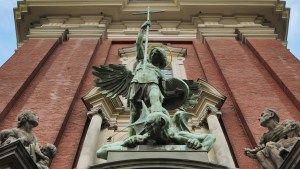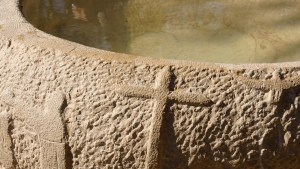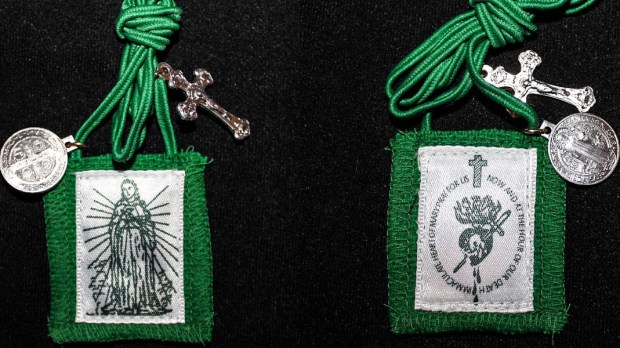Sacramentals are objects set apart and blessed by the Church for the purpose of sanctifying our lives and leading us to the sacraments. They are sacred signs and a channel of grace (spiritual help) through the intercession of the Church.
One of the most popular sacramentals in the Church is the brown scapular. A devotional scapular (from the Latin word for “shoulders”) is a miniaturized version of the poncho-like garment worn by many monks and nuns. It consists of two small squares of cloth, to which printed religious images have been sewn, suspended from a ribbon and worn — usually under the daily clothing — so that one square rests in front and one in back.
Attached to the devout use of a scapular are certain graces that God offers; these heavenly graces are dependent on the faith of the person wearing the scapular and are not automatic.
Read more:
Is the brown scapular just a Catholic “lucky charm”?
The brown scapular, associated with a vision of Our Lady by the 13th-century English Carmelite St. Simon Stock, is the most widely known. Many Catholics are surprised to learn, however, that the Church has approved not just the brown scapular, but more than a dozen similar sacramentals. In total there are about 18 scapulars that can be used with faith.
Here are seven scapulars you may not be familiar with. For a full list of the scapulars, check out the Catholic Encyclopedia.
The White Scapular of the Most Blessed Trinity
Approved by Innocent III in 1198, the white scapular was developed by the Order of the Trinitarians, originally for their religious habit. The scapular came into existence after an angel appeared wearing a white garment, having on his breast a cross that was blue and red in color. Those who wanted to associate themselves with the order wore a small white devotional scapular with a similar blue and red cross.
The Black Scapular of the Seven Dolors (Sorrows) of Mary
Associated with the Servite Order founded in 1255, this small black scapular contains an image of Our Lady of Sorrows. It is worn by those who wish to participate in the spirituality of the Servite Order, which is particularly devoted to the Sorrowful Mother.
The Blue Scapular of the Immaculate Conception
Based on the vision of Venerable Ursula Benincasa, the sky-blue scapular is derived from the habit of the Theatine Order. It is worn in honor of the Immaculate Conception of the Blessed Virgin Mary, and in hopes of converting sinners.
The Red Scapular of the Passion
This scapular came into existence due to a vision to a sister in the Congregation of the Daughters of Charity in 1846. The apparition of Jesus to the sister showed her the scapular to be worn every Friday. It consists of red cloth that has the cross, implements of Jesus’ Passion and the words, “Holy Passion of Our Lord Jesus Christ, save us.” On the reverse side there are the Sacred Hearts of Jesus and Mary, and a cross with the inscription, “Sacred Hearts of Jesus and Mary, protect us.” The scapular is worn for the intention of increasing faith, hope, and charity.
The Green Scapular of the Immaculate Heart of Mary
The green scapular was received by another sister in the Congregation of the Daughters of Charity in 1840. Besides being green in color, it contains an image of Our Lady and her Immaculate Heart. The only words on the scapular are “Immaculate Heart of Mary, pray for us now and at the hour of our death.” The particular intention associated with this scapular is that of conversion.
The Scapular of St. Michael the Archangel
This scapular was formally approved by Pope Leo XIII (who developed the St. Michael Prayer) and was associated with a special Confraternity of St. Michael the Archangel. Instead of a square piece of cloth, the scapular is in the form of a shield. It is blue and black in color, featuring an image of St. Michael with the words, Quis ut Deus (“Who is like God?” — a direct translation of the Hebrew name Michael).

Read more:
The demonic vision that inspired the St. Michael Prayer
The Scapular of St. Joseph
Approved in 1880, this scapular was spread by the Capuchin Order and consists of a violet and gold cloth. On one side it has an image of St. Joseph with the Child Jesus and the words, “St. Joseph, patron of the Church, pray for us.” On the reverse side it has the dove, cross and keys of Peter with the words, “The Spirit of the Lord is his Guide.”

Read more:
3 Powerful sacramentals to have in your home

